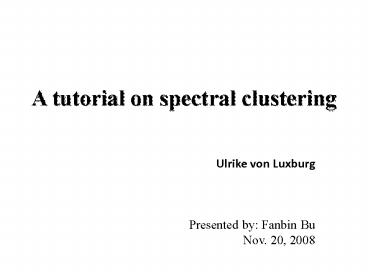A tutorial on spectral clustering PowerPoint PPT Presentation
1 / 24
Title: A tutorial on spectral clustering
1
A tutorial on spectral clustering
- Ulrike von Luxburg
- Presented by Fanbin Bu
- Nov. 20, 2008
2
Outline
- Introduction
- Graph Laplacians and their basic properties
- Spectral clustering algorithms
- Why do these algorithms work?
- Practical details
3
Introduction
- Graph notation. G(V,E)
- Adjacency matrix
- Degree matrix D
- A the number of vertices in A
- vol(A)
4
Introduction
- Similarity graphs
- The epsilon-neighborhood graph
- Connect all points whose pairwise distances are
smaller than epsilon. - K-nearest neighbor graph
- Connect vertex vi with vertex vj if vj is among
the k nearest neighbor of vi - K nearest neighbor graph
- Mutual k nearest neighbor graph
- The fully connected graph
- Connect all points with positive similarity
5
(No Transcript)
6
Graph Laplacians
- Every author calls his matrix the graph
Laplacian. - Assume that G is an undirected.
- Different graph Laplacians
- Unnormalized
- Normalized
- Symmetric
- Random walk
7
Properties of Graph Laplacian L
8
Properties of Graph Laplacian L
9
PROPERTIES OF L_SYM AND L_RW
10
PROPERTIES OF L_SYM AND L_RW
11
Spectral clustering algorithms
12
Spectral clustering algorithms
13
Spectral clustering algorithms
14
A toy example
200 points, Gaussian distribution Similarity
function Similarity graph fully
connected 10-nearest neighbor Graph
Laplacians unnormalized L normalized L_rw
15
(No Transcript)
16
Why do these algorithms work?
- Graph cut point of view
- Random walks point of view
- Perturbation theory point of view
17
Graph cut point of view
- For two disjoint subsets
- For k subsets, want to minimize
- Problem the solution simply consists in
separating one individual vertex from the rest of
the graph. - Solution explicitly request large subsets.
18
RatioCut
- Standard trace minimization problem solution is
given by - the Rayleigh-Ritz theorem. H is the matrix
which contains - the first k eigenvectors of L as columns. HU
19
Ncut
- Standard trace minimization problem solution is
given by - the Rayleigh-Ritz theorem. H is the matrix
which contains - the first k eigenvectors of L_rw as columns.
20
Random walks point of view
- Transition matrix
- Graph Laplacian
- Relation between Ncut and random walk
- When minimizing Ncut, we actually look for a cut
through the graph such that a random walk seldom
transitions from A to the rest of A and vice
versa.
21
Perturbation point of view
- Ideal case between-cluster similarity is 0
- The first k eigenvectors of L/L_rw are
indicators. - K-means finds the clusters trivially.
- Nearly ideal case between-cluster similarity is
close to 0. - Eigenvectors are close to ideal indicator
vectors. - Formal perturbation argument Davis-Kahan.
22
Perturbation point of view
- In the ideal case, the eigenvectors of L and L_rw
are indicator vectors. No problem! - In the ideal case, the eigenvectors of L_sym is
- Problem vertex with low degree.
- Problem still exists even after
row-normalization.
23
Practical details
- Constructing the similarity graph
- Similarity function
- Choice of similarity graph
- Type
- Parameters
- Computing the eigenvectors
- Sparse matrix
- Krylov subspace method Lanczos method
- The number of clusters
- Eigengap heuristic
- Choosing graph Laplacian
- Normalized graph Laplacian L_rw recommended
- Regular graph, same degree. Not a big deal.
24
Thank you!

